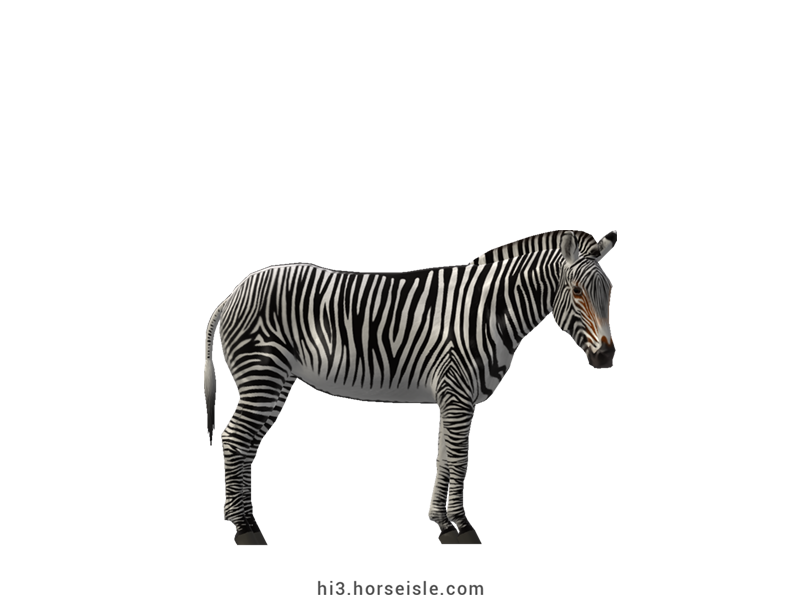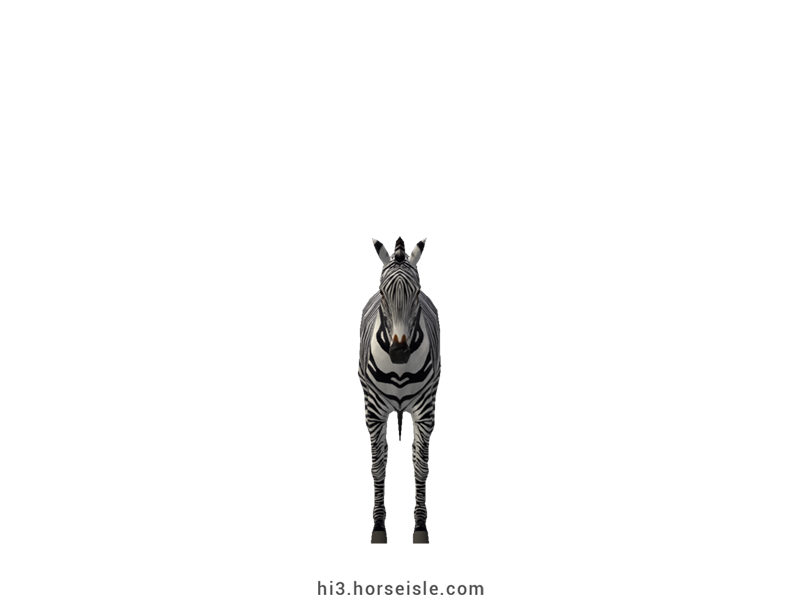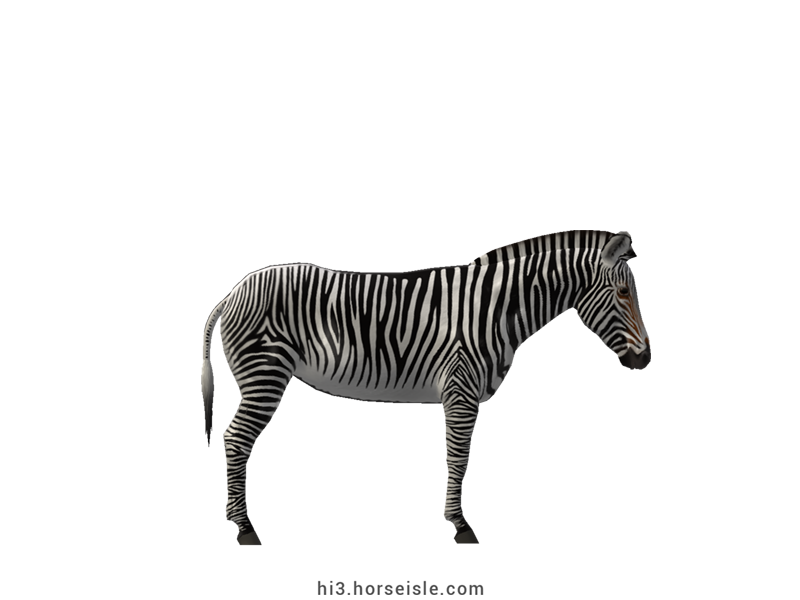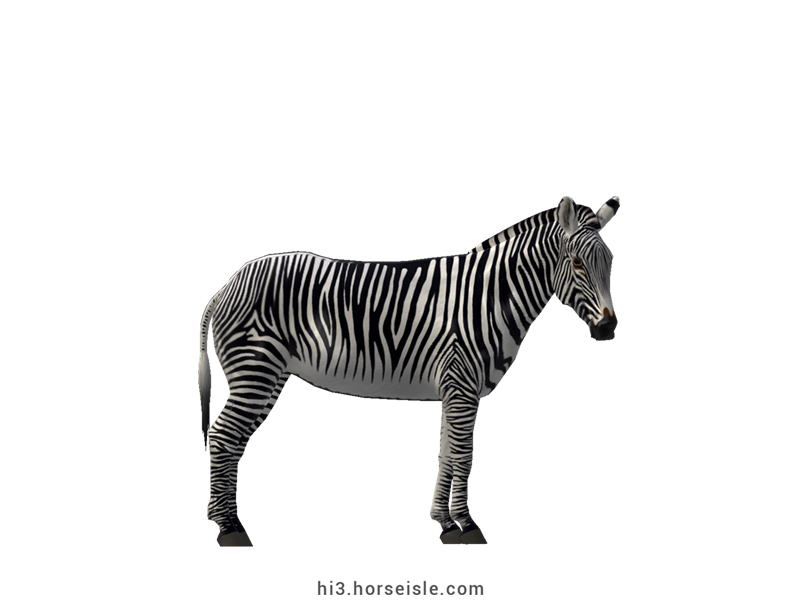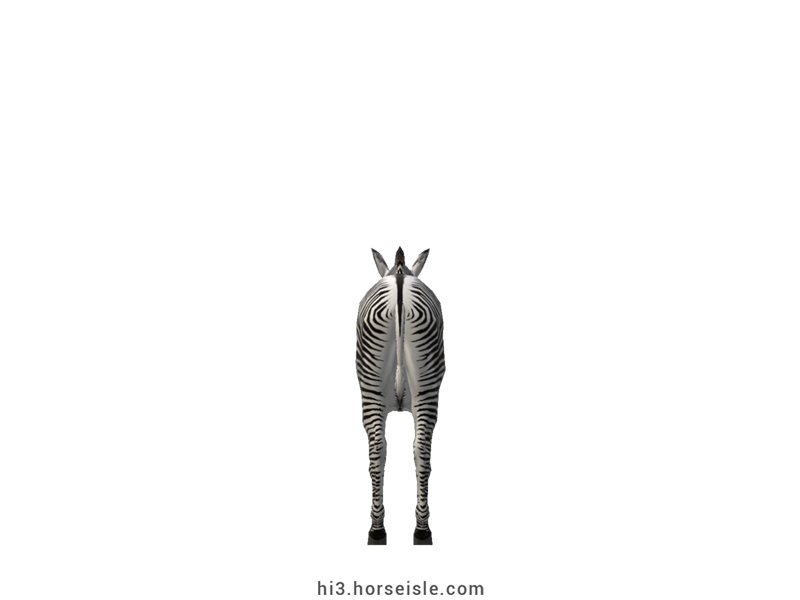Our Massive Real World Equine Reference!
[ INDEX ] Equine Type: Zebra Breed: Grevy's Zebra [ PREV ] [ NEXT ]
Unlike the Mountain and Plains zebras which were known before the 19th century, the Grevy's zebra was officially recognized over a century later. In 1882, a Grevy's zebra was sent from Ethiopia to France, as a token of honor from Ethiopian president Menelik II to the French president Jules Grevy. It is after the latter that the Grevy's zebra was named, by the French zoologist Emile Oustalet who correctly concluded, based on its unique coat, that the Grevy's zebra is a separate zebra species from the Plains and Mountains zebras.
Coat Pattern:
The pattern of the Grevy's coat is vastly different from the coat patterns of the Plains and Mountain zebras. The dark stripes -- which from now on will be referred to as 'stripes' -- are narrower and more numerous, especially on the thighs which also sport a unique triangular pattern.
The stripes on the sides of the barrel are always vertical, and end slightly above the height of the stifle. The abdomen is completely white except for a thick, dark, single line that runs along the stomach.
Another thick, dark line runs along the zebra's back, from the withers to its tail, although it is smoother than the abdominal line. Starting from about the middle of the dorsal line, the stripes on the sides of the body don't connect to the dorsal line, leaving a white gap on both of its sides.
The shoulders of Grevy's zebras exhibit a triangular pattern similar to the one seen in Plains and Mountain zebras, but in Grevy's zebras this pattern is made of finer and more numerous stripes.
Likewise, the pattern on the head of Grevy's zebras is also "similar-but-different". The stripes on the front of the head are thin in the center and widen as they get closer to the eyes, similar to what seen in Plains zebras. However, the stripes of the Grevy's zebra merge along the centerline to create a row of arches, rather than merging on or near the forehead. In addition, at their bottom, the stripes end abruptly when they reach a thick, white patch above the muzzle.
The white band above the muzzle is unique for Grevy's zebras, whose muzzle also has a brownish color. For comparison, in both Plains and Mountain zebras the stripes on the front of the head merge into the muzzle.
The pattern at the back of the ears is also unique, and is characterized by a white eartip, and a dark patch underneath which breaks into smaller dark patches and dark spots.
A lot more can be written about the unique pattern of the Grevy's zebra, but the characteristics mentioned above are sufficient to help one recognize a Grevy's zebra.
The Grevy's Zebra Today:
Today, Grevy's zebras roam in East Africa, in the semi-arid scrublands and grasslands in Ethiopia and northern Kenya. Unlike Plains zebras that live in large herds, Grevy's zebras live either solitary or in small groups, but they often roam among large herds of other herbivores. They spend most of the day foraging for grass and leaves, as well as for fruit and bark.
Mature Grevy's stallions are territorial, and stallions will challenge and fight each other to gain a territory. Territories that contain water sources are in particularly high demand, because they are the ones that are most likely to attract the attention of the mares. While Grevy's zebras can survive up to five days without drinking water, both mares and stallions don't aspire to do so. Especially nursing mares, who must drink water every one or two days in order to produce enough milk for their foals.
Mares constantly roam in-and-out of stallion territories, and can either roam alone or in small groups. Males who are younger than six years, as well as stallions who don't have claim to a territory, usually roam in small groups. They are allowed to roam in the territories of stallions if there are no mares nearby, and as long as they behave nicely.
It might sound as if Grevy's zebras live pleasant lives today, but the opposite is true. Grevy's zebras rely on large habitats and access to water for their survival, especially when it comes to the survival of foals. Today, loss of habitat drives Grevy's zebras to extinction, and conservation projects are taking place to prevent this unique species from being wiped out.
Conformation:
The conformation of Grevy's zebras is different from the conformation of Plains and Mountain zebras. The muzzle and neck are longer, the girth is sometimes narrower, and the legs are sometimes longer. The most striking difference is in their ears, which are significantly wider and longer than in other zebra species.
Performance metrics:
The following are the: range, average, (SD), and MOE of performance metrics of ordered Grevy's zebras in Horse Isle (not bred ones). In rare cases,
Speed: 14.2-16.6, 15.4 (0.6), 0.11.
Sprint: 40-54, 47 (4), 0.7.
Accel: 0.84-1.04, 0.93 (0.04), 0.01.
Decel: 0.75-0.92, 0.84 (0.04), 0.01.
Jump: 4.96-5.21, 5.09 (0.06), 0.01.
Pull: 0.89-1.64, 1.26 (0.18), 0.04.
Turning: 41.78-52.11, 46.95 (2.24), 0.44.
Reverse: 2.2-2.7, 2.4 (0.1), 0.02.
Stamina: 43.91-51.08, 47.78 (1.58), 0.31.
Reaction: 0.63-0.75, 0.69 (0.03), 0.00.
Height:
Grevy's zebras are taller on average than all other zebra species, and stand between 12hh and 15.3hh.
[ INDEX ] [ PREV ] [ NEXT ]


